
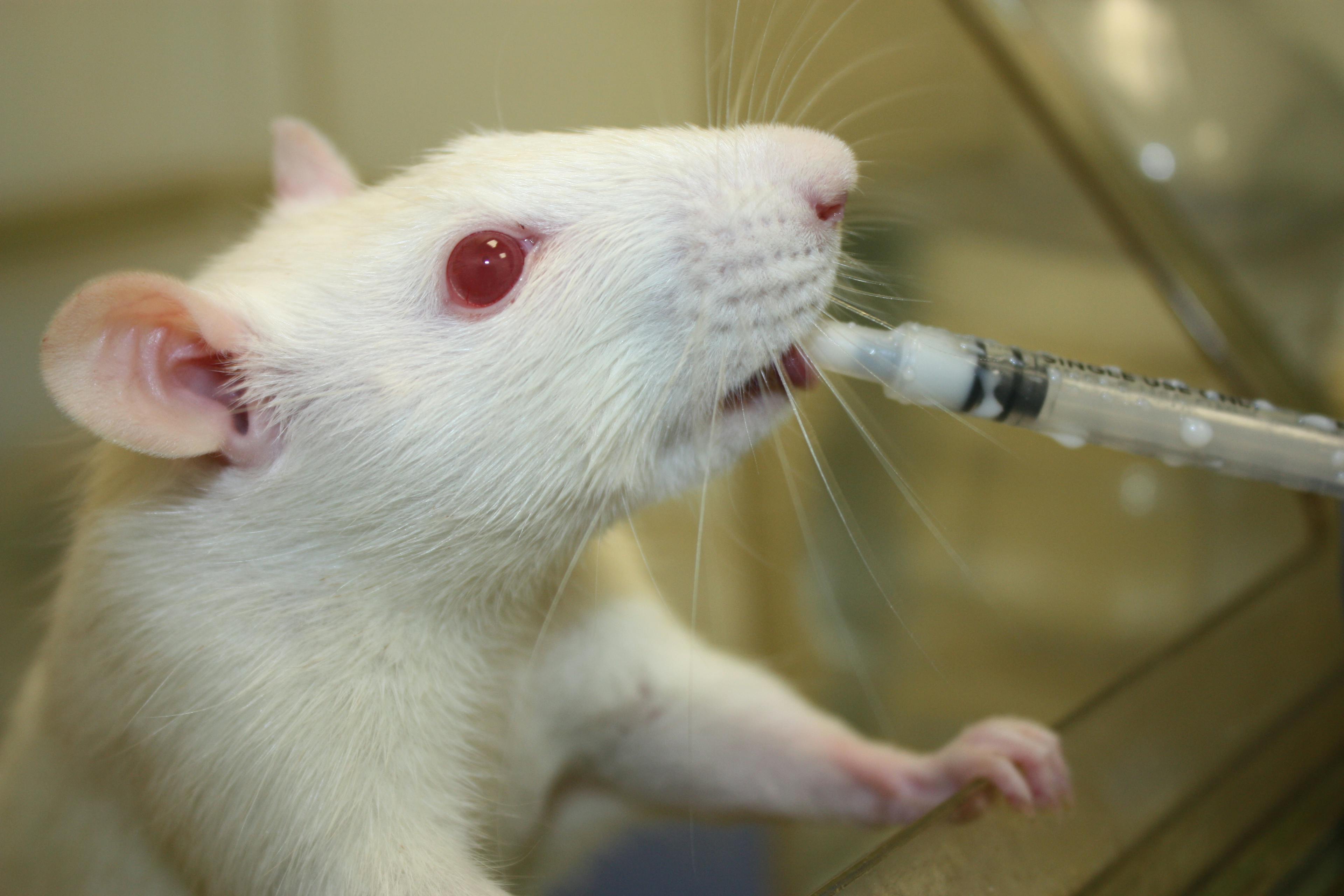
Habituation
An introduction to animal habituation.
Animals will learn from every experience they have so be mindful that every time you interact with an animal you are teaching it something.
There are important differences between habituation protocols which gradually introduce the animal to a specific environment or procedure (including handling) and methods which generate passive coping strategies, such as learned helplessness. The behavioural outcome may be similar i.e. the animal stops exhibiting struggling behaviours or vocalisations, but the affective experience is very different. Learned helplessness is an established consequence of repeated experience of an inescapable stress and used as a model of depression.
The aim of habituation is to train the animal to accept a procedure but to achieve this gradually with the goal of minimising any aversive experience. It is much more difficult to overcome conditioned aversion, where the animal has formed a negative association with the situation.
There are lots of examples of where graduated training schedules have been used to train non-human primates to accept injections or blood sampling without restraint as well as different species of animals managed in zoos. Rodents are similarly capable of being trained to accept interventions and one of the simplest but maybe most important is handling by humans.
In this section, we describe protocols we have developed for rats and mice which aim to generate a positive association with human handling and minimise any aversive experiences.
Habituation protocols for mice and rats
General principles
Most animals arrive at a facility from breeding establishments and will have already experienced repeated human handling. Ideally, animals in breeding facilities will have been habituated to handling but irrespective of the animal’s past experiences, habituation prior to experimental procedures will reduce stress. Pairing human interactions with a positive experience shifts the animal’s affective state and can reduce the cumulative impacts of brief negative experiences. Graduated stages of habituation reduce the likelihood of the animal experiencing a fearful state and conditioned aversion (where the experience becomes associated with a negative affective state which can be re-activated).
Positive associations with human handling can be achieved by pairing handling with either a food reward or access to a highly enriched environment e.g. a playpen.
For the animal to form a direct and positive association with handling, the reward needs to occur within a short time frame.
Habituation vs passive coping strategies
Passive coping and learned helplessness develop when an animal experiences uncontrollable stress. It is difficult to quantify the affective state of these animals objectively as overt signs of distress are not present and stress hormone response can become blunted, however, uncontrollable stress is an established model of depression. Production of faecal pellets may still occur and can provide some indication of affective state with well habituated animals producing few if any faecal pellets during handling or procedures carried out using refined methods.
Habituated animals also adapt in their behaviour but, if performed correctly no overt signs of distress should be present at any stage. By introducing the process of handling gradually, the degree of fear which the animals experience is minimised. This makes the process of associating human handling with a positive experience more likely to predominate. Once animals are habituated to handling, they will tolerate minor periods of aversive interventions without showing evidence of any longer-term impacts.
Habituating to Handling
Habituating mice to handling
Day 1 – open cage and remove all furnishings accept a familiar tube. Keeping the tube within the cage, lift the mouse in the tube and gently encourage to step over your hand back into the cage. It is sometimes easier to get mice to reverse onto your hand by tipping the tube slightly upward with the mouse facing down hill. Repeat a few times and for each animal in the cage and then place reward into the cage and replace all furniture and lid.
Day 2 – repeat day one but try to have the mouse pause on the hand with gentle cupping each time. With cup handling, the mouse should not feel restrained and should be released if it starts trying to evade handling.
For animals which do not require physical handling for the procedures repeat tube handling habituation days 3-5.
Day 3 – for animals requiring physical restraint for procedures progress to cup handling. Repeat day 2 but cup restrain the mouse for a brief period of time before release. Gradually increase the time restrained as the animals tolerance increases.
Day 4-5 – repeat day 3 increasing time animal is cup restrained.
NB. Individual and strain specific differences will impact on the number of sessions required for the animals to accept each stage and it is important not to progress to a new stage before the animal is comfortable with the current one.
A playpen can be used as an alternative to food rewards. Mice can be tube handled from the cage to the play pen and then returned to the homecage following the same steps as described above. Once the mice are familiar with cup handling, this can replace tube handling to and from the play pen.
Training the mice to sit on a piece of vet bed can be helpful and is a method which researcher at RiSE have shown to particularly beneficial (see https://www.ri.se/en/what-we-do/expertises/3r-focus-on-animal-welfare)
To benefit training in the head fixation set-up consider next moving onto free exploration of the apparatus with positive reinforcement and then introducing restraint for very short periods of time e.g. a few seconds. The time of restraint can be gradually increased and paired with reward to help avoid animals developing an aversive association with the experience.
Guidance documents with detailed protocols for habituating and handling mice can be found in the additional resources section.
This series of videos illustrates the different stages used for habituating mice to handling as detailed in the guidance document.
Step 1 - Preparing the cage
The cage is cleared of any enrichment, leaving only a familiar cardboard tube for handling.
Step 2 - Tube handling - Example 1
The animal is guided towards the tube and tube briefly lifted up from the cage floor, with the animal encouraged to return to the cage from the tube over the handler's hand.
Step 2 - Tube handling - Example 2
Step 3 – Tube handling to cup handling - Example 1
The animal is moved from the tube to the hand and briefly held before returning to the cage. The duration the animal is held in the cup position is gradually increased and adapted for each animal. Most animals need only one experience per day but if an animal is not showing improvements the number of times is handled in the session can be increased to 3-5.
Step 3 – Tube handling to cup handling - Example 2
Step 4 - Tube handling to vet bet
Training animals to sit on a piece of vet bed can be useful for future procedures. Animals can be acclimatised to being moved from the cage to vet bed via a tube. Positive reinforcement can also be given on the vet bed to help form a positive association.
Step 4 - Cup handling to vet bed
Handling mice to transfer between locations e.g. for cage cleaning or for transport
Habituation should be used for any handling procedures animals may need to experience.
Rewarding with condensed milk in the cage - Example 1
After each habituation session, providing positive reinforcement in the cage helps form a positive association with handling.
Rewarding with condensed milk in the cage - Example 2
Rewarding with pellets in the cage
Following habituation to handling, mice should ready accept handling direct from the cage
Habituating rats to handling
Day 1 – cage lid off, furniture removed, remaining within the confines of the cage, pick up the rat around the shoulder then immediately put back in cage. Repeat with each cage mate then give reward in home cage
Day 2 – cage lid off, furniture removed, pick up and transfer to a travel box containing rewards, move all rats from the cage to the travel box, give additional rewards then once consumed, pick up and return to cage, give reward in cage
Day 3 – open cage lid and wait for rat to approach then pick up, transfer to travel box containing reward, move all rats from the cage to the travel box, give additional rewards then once consumed, pick up and return to cage, give reward in cage
Day 4/5 – repeat day 3 and start introducing dosing positions and taking palatable solutions from a syringe. If using palatable dose training, this can also serve as the reward.
Rats can also be trained to sit on a piece of vet bed to facilitate handling for procedures. By providing rewards whilst sitting on the vet bed, the animals form a positive association with the context which can mitigate the effects of subsequent mildly aversive procedures such as subcutaneous injection or for procedures in animals with head mounted devices.
Guidance documents with detailed protocols for habituating and handling mice can be found in the additional resources section.
This series of videos illustrates the different steps for habituating rats to handling and positive reinforcement.
Step 1 - Preparing the cage
Step 2 - Brief handling within the cage to acclimatise to initial contact
Step 2 - Tube handling
Step 2 - picking up in the cage
Rewarding in the cage after handling helps for positive associations
Rewarding using a palatable solution can be used during habituation to also train animals for future oral dosing
Habituation to moving to a different locations - Example 1
Habituation to moving to a different locations - Example 2
To prepare animals for procedures they are habituated to being moved to the arm or vet bed - Example 1
To prepare animals for procedures they are habituated to being moved to the arm or vet bed - Example 2
Example of habituated rats
Habituating animals for repeated or extended periods of restraint
Restraining animals for procedures involving extended periods of time
Once an animal is habituated to handling, this can be extended to train them to accept longer periods of being held still to enable procedures such as non-invasive blood pressure monitoring, targeted brain infusions, tethering via head mounted devices.
Habituating animals for these procedures involves the same principles as basic habituation with the animal gradually introduced to the procedure and period of restraint needed using positive reinforcement and avoiding any aversive experiences. Animals which have been habituated to handling learn quickly.
Animals can be trained to sit on a piece of vet bed using positive reinforcement to facilitate handling for procedures. The size of the vet bed used can also be gradually reduced to help animals learn to stay in one position.
The procedures should not cause more than brief transient discomfort and so the main aim is to train the animal to accept being still to enable the procedure to be carried out. This is achieved by gradually increasing the time the animal is held for in the position needed e.g. with the head held firmly to enable tethering. The animal should not reach a point where it struggles or vocalises and any restraint should be stopped at the first signs of the animal becoming distressed. By repeating the handling and increasing the time gradually, both rats and mice can learn to accept being restrained
Habituation methods to refine head fixed protocols
Restraining mice using head fixation protocols has the potential to cause significant distress. This will adversely impact on the scientific outcomes. Animals will not train in behavioural tasks properly and require higher levels of food or water restriction to motivate behaviour. Following the principles outlined here, and habituating mice to handling before starting procedures can help reduce the distress of head fixation. Mice should also be slowly introduced to head fixation e.g. first habituating to the apparatus without fixation followed by very brief periods of head fixation with rewards. Monitoring rates faecal pellets and rates of learning are helpful to optimise habituation for the specific procedures being used. Comparing learning rates for headfixed versus non-headfixed animals in the same paradigm as well as monitoring levels of restriction needed to sustain behaviour is also useful.
This series of videos illustrates a rat being gently restrained to facilitate interaction with a head mounted device
Restraining for infusions – restraint
Restraining for infusions - dummy out
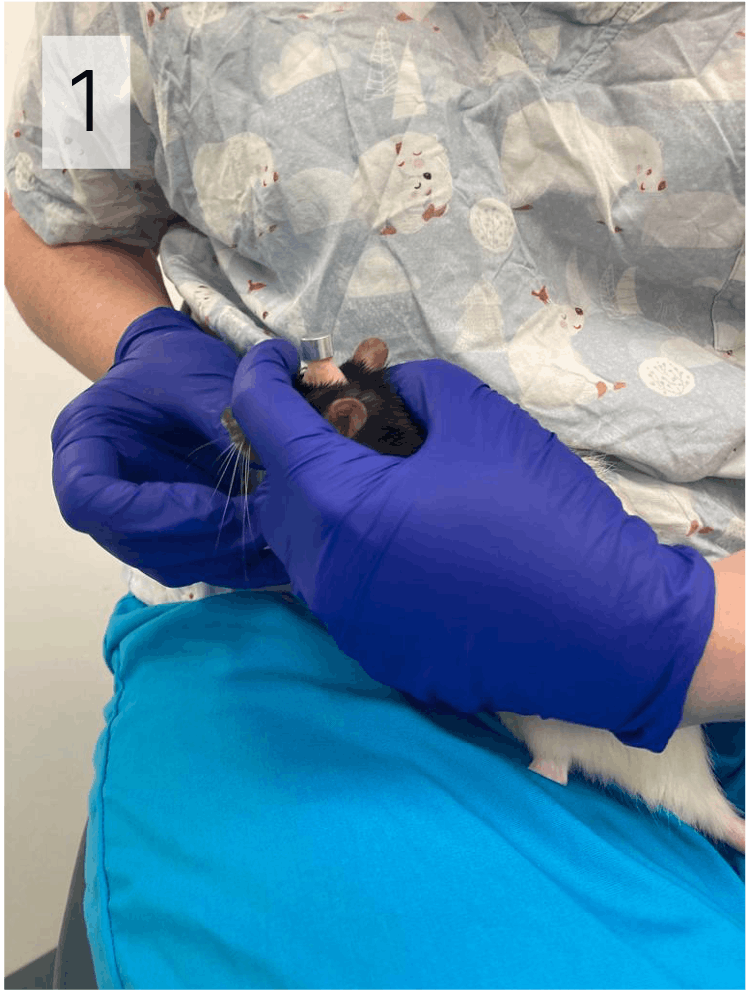
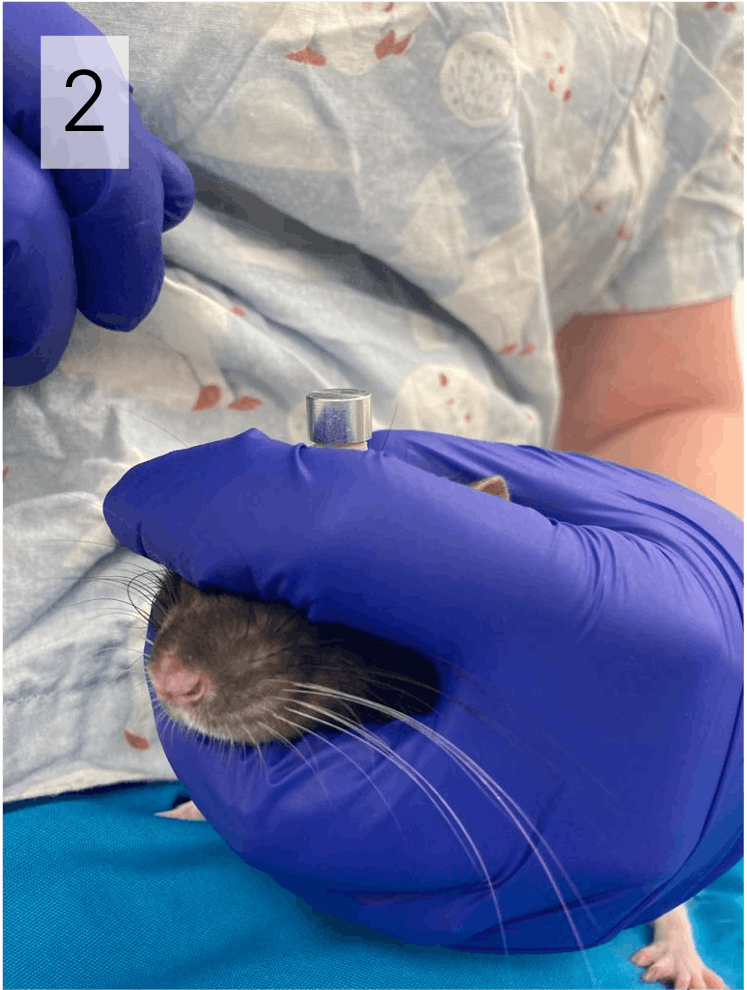
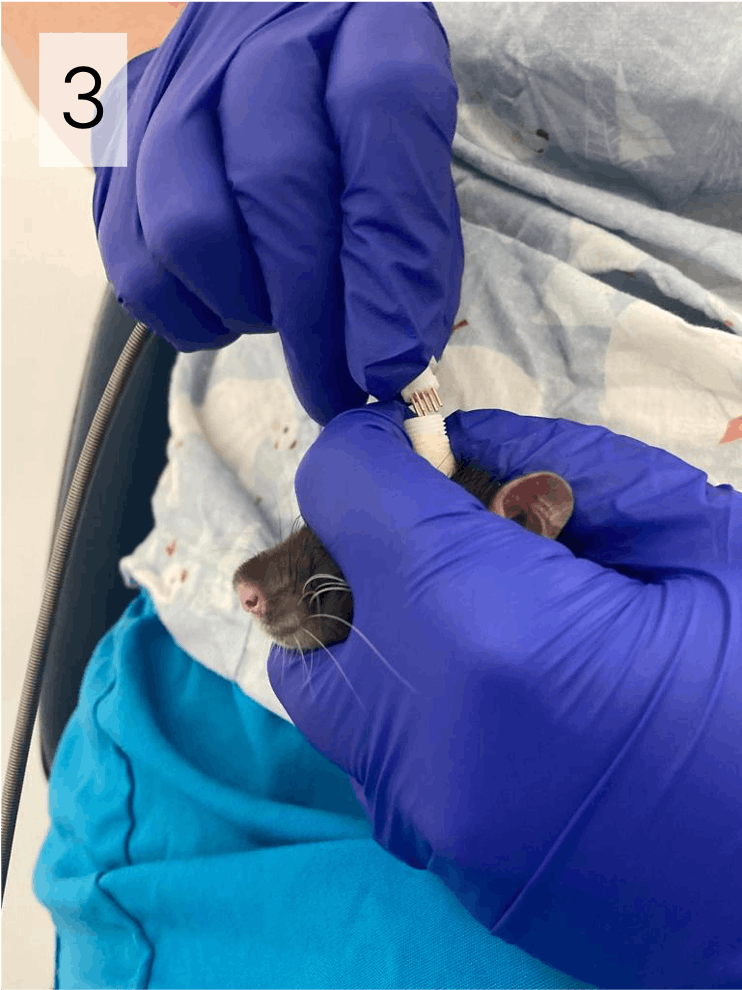
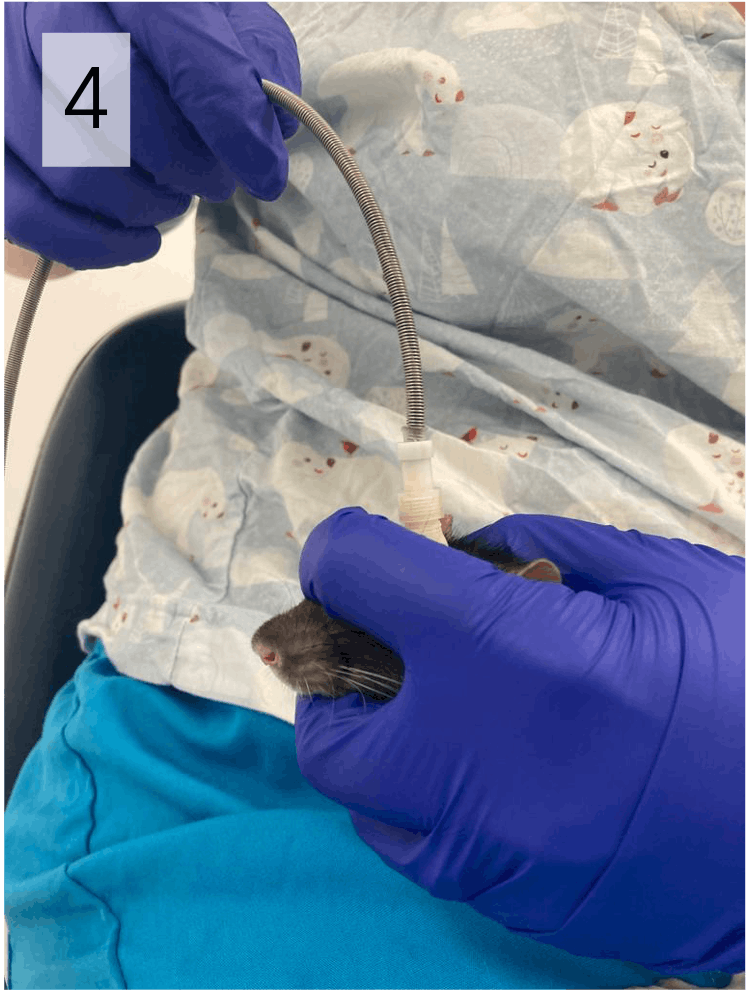
Restraining a rat to enable tethering to a head mounted device